Biography
Straus was born in Chicago in 1897. He pursued a career as a newspaperman, serving as managing editor of the Chicago Evening Post and rising to the position of Washington, D.C. bureau chief of the International News Service. In 1933, Harold L. Ickes, the newly appointed Secretary of the United States Department of the Interior, selected Straus as a personal aide and handler of the Cabinet secretary's press relations.
The Chicago Evening Post was a daily newspaper published in Chicago, Illinois, from March 1, 1886, until October 29, 1932, when it was absorbed by the Chicago Daily News. The newspaper was founded as a penny paper during the technological paradigm shift created by linotype; it failed when the Great Depression struck.
The International News Service (INS) was a U.S.-based news agency (newswire) founded by newspaper publisher William Randolph Hearst in 1909. In May 1958 it merged with rival United Press to become United Press International.
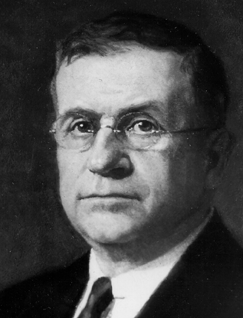
Harold LeClair Ickes was an American administrator and politician. He served as United States Secretary of the Interior for 13 years, from 1933 to 1946, the longest tenure of anyone to hold the office, and the second longest-serving Cabinet member in U.S. history after James Wilson. Ickes and Labor Secretary Frances Perkins were the only original members of the Roosevelt cabinet who remained in office for his entire presidency.
Straus served at Ickes's side during his chief's tenure at the Interior Department, rising to the position of First Assistant Secretary of the Department in March 1943. In 1946, soon after the death of President Franklin D. Roosevelt, Ickes resigned from the Cabinet. Straus continued as part of the new Truman Administration, moving laterally in December 1945 to the position of Commissioner of the Bureau of Reclamation within the Interior Department.

Franklin Delano Roosevelt, often referred to by his initials FDR, was an American statesman and political leader who served as the 32nd president of the United States from 1933 until his death in 1945. A Democrat, he won a record four presidential elections and became a central figure in world events during the first half of the 20th century. Roosevelt directed the federal government during most of the Great Depression, implementing his New Deal domestic agenda in response to the worst economic crisis in U.S. history. As a dominant leader of his party, he built the New Deal Coalition, which realigned American politics into the Fifth Party System and defined American liberalism throughout the middle third of the 20th century. His third and fourth terms were dominated by World War II. Roosevelt is widely considered to be one of the most important figures in American history, as well as among the most influential figures of the 20th century. Though he has also been subject to much criticism, he is generally rated by scholars as one of the three greatest U.S. presidents, along with George Washington and Abraham Lincoln.

Harry S. Truman was the 33rd president of the United States from 1945 to 1953, succeeding upon the death of Franklin D. Roosevelt after serving as vice president. He implemented the Marshall Plan to rebuild the economy of Western Europe, and established the Truman Doctrine and NATO.
Straus's tenure at Reclamation during the late 1940s coincided with one of the Bureau's most intensive period of concrete dam-building, with numerous structures built in the Columbia River, the Colorado River drainage, and other major watersheds across the American West. Straus presided over the construction and dedication of dams such as Hungry Horse Dam in Montana. He left his position in 1953 soon after the inauguration of President Dwight D. Eisenhower.

The Columbia River is the largest river in the Pacific Northwest region of North America. The river rises in the Rocky Mountains of British Columbia, Canada. It flows northwest and then south into the US state of Washington, then turns west to form most of the border between Washington and the state of Oregon before emptying into the Pacific Ocean. The river is 1,243 miles (2,000 km) long, and its largest tributary is the Snake River. Its drainage basin is roughly the size of France and extends into seven US states and a Canadian province. The fourth-largest river in the United States by volume, the Columbia has the greatest flow of any North American river entering the Pacific.

The Colorado River is one of the principal rivers in the Southwestern United States and northern Mexico. The 1,450-mile-long (2,330 km) river drains an expansive, arid watershed that encompasses parts of seven U.S. and two Mexican states. Starting in the central Rocky Mountains of Colorado, the river flows generally southwest across the Colorado Plateau and through the Grand Canyon before reaching Lake Mead on the Arizona–Nevada border, where it turns south toward the international border. After entering Mexico, the Colorado approaches the mostly dry Colorado River Delta at the tip of the Gulf of California between Baja California and Sonora.
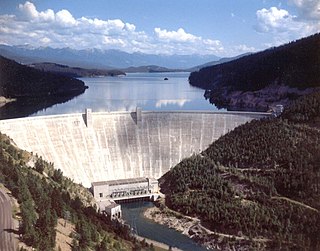
Hungry Horse Dam is an arch dam in the western United States, on the South Fork Flathead River in the Rocky Mountains of northwest Montana. It is located in Flathead National Forest in Flathead County, about fifteen miles (24 km) south of the west entrance to Glacier National Park, nine miles (14 km) southeast of Columbia Falls, and twenty miles (32 km) northeast of Kalispell. The Hungry Horse project, dam, and powerplant are operated by the U.S. Bureau of Reclamation. The entrance road leading to the dam is located in Hungry Horse.

Hoover Dam is a concrete arch-gravity dam in the Black Canyon of the Colorado River, on the border between the U.S. states of Nevada and Arizona. It was constructed between 1931 and 1936 during the Great Depression and was dedicated on September 30, 1935, by President Franklin D. Roosevelt. Its construction was the result of a massive effort involving thousands of workers, and cost over one hundred lives. Originally known as Boulder Dam from 1933, it was officially renamed Hoover Dam, for President Herbert Hoover, by a joint resolution of Congress in 1947.

The United States Secretary of Agriculture is the head of the United States Department of Agriculture. The Secretary of Agriculture is former Georgia Governor Sonny Perdue. Perdue took office on April 25, 2017 after being confirmed by the U.S Senate 87-11. The position carries similar responsibilities to those of agriculture ministers in other governments.

The United States Secretary of the Interior is the head of the United States Department of the Interior. The Department of the Interior in the United States is responsible for the management and conservation of most federal land and natural resources; it oversees such agencies as the Bureau of Land Management, the United States Geological Survey, and the National Park Service. The Secretary also serves on and appoints the private citizens on the National Park Foundation board. The Secretary is a member of the President's Cabinet. The U.S. Department of the Interior should not be confused with the Ministries of the Interior as used in many other countries. Ministries of the Interior in these other countries correspond primarily to the Department of Homeland Security in the U.S. Cabinet and secondarily to the Department of Justice.

The Reclamation Act of 1902 is a United States federal law that funded irrigation projects for the arid lands of 20 states in the American West.

Grand Coulee Dam is a concrete gravity dam on the Columbia River in the U.S. state of Washington, built to produce hydroelectric power and provide irrigation water. Constructed between 1933 and 1942, Grand Coulee originally had only two powerhouses. The third powerhouse, completed in 1974 to increase energy production, makes Grand Coulee the largest power station in the United States by nameplate-capacity at 6,809 MW.

The United States Bureau of Reclamation (USBR), and formerly the United States Reclamation Service, is a federal agency under the U.S. Department of the Interior, which oversees water resource management, specifically as it applies to the oversight and operation of the diversion, delivery, and storage projects that it has built throughout the western United States for irrigation, water supply, and attendant hydroelectric power generation. Currently the USBR is the largest wholesaler of water in the country, bringing water to more than 31 million people, and providing one in five Western farmers with irrigation water for 10 million acres of farmland, which produce 60% of the nation's vegetables and 25% of its fruits and nuts. The USBR is also the second largest producer of hydroelectric power in the western United States.

David William Davis was the 12th Governor of Idaho, serving from 1919 to 1923. He later served briefly as Commissioner of the U. S. Bureau of Reclamation. From that, he became a Special Assistant to the Secretary of the Department of Interior.

Franklin D. Roosevelt Lake is the reservoir created in 1941 by the impoundment of the Columbia River by the Grand Coulee Dam in Washington state. It is named for Franklin D. Roosevelt, who was President during the construction of the dam. Covering 125 square miles, it stretches about 150 miles (240 km) from the Canada–US border to Grand Coulee Dam, with over 600 miles (970 km) of shoreline; by surface area it is the largest lake and reservoir in Washington. It is the home of the Lake Roosevelt National Recreation Area.

Parker Dam is a concrete arch-gravity dam that crosses the Colorado River 155 miles (249 km) downstream of Hoover Dam. Built between 1934 and 1938 by the Bureau of Reclamation, it is 320 feet (98 m) high, 235 feet (72 m) of which are below the riverbed, making it the deepest dam in the world. The dam's primary functions are to create a reservoir, and to generate hydroelectric power. The reservoir behind the dam is called Lake Havasu and can store 647,000 acre⋅ft (798,000,000 m3) or over 210 billion US gallons. The dam straddles the state border at the narrows the river passes through between the Whipple Mountains of California and the Buckskin Mountains of Arizona.

Elwood Mead was a professor, politician and engineer, known for heading the United States Bureau of Reclamation (USBR) from 1924 until his death in 1936. During his tenure, he oversaw some of the most complex projects the Bureau of Reclamation has undertaken. These included the Hoover, Grand Coulee and Owyhee dams.
The Commissioner of Education was the title given to the head of the federal Office of Education, which was historically a unit within and originally assigned to the Department of the Interior in the United States. The position was created on March 2, 1867, when an Act to establish the Office of Education took effect under the influence of the more Radical Republican Party influences from the Northern states and New England which were much more progressive in the fields of education and had already established many state departments of education and created a large number of public schools and systems in cities, towns and counties, both on the elementary (grammar) school level and the high schools, in which the South had lagged behind.
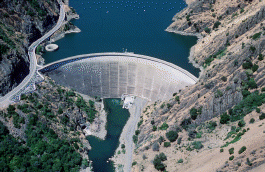
Monticello Dam is a 304-foot (93 m) high concrete arch dam in Napa County, California, United States constructed between 1953 and 1957. The dam impounded Putah Creek to create Lake Berryessa in the Vaca Mountains.
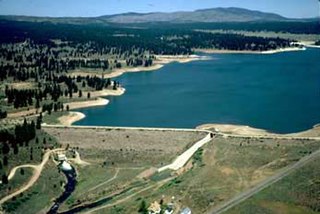
Boca Dam is an earthfill dam and a part of the Truckee Storage Project that encompasses Nevada County, California and Washoe County, Nevada in the United States. Open year-round, it is located at the southern end of Boca Reservoir, 1 mi (2 km) north of Interstate 80, 0.3 mi (480 m) above the confluence of the Little Truckee River and the Truckee River, and 6 mi (9.7 km) northeast of Truckee, California. Reno, Nevada lies 27 mi (43 km) to the east.

The Main Interior Building, officially known as the Stewart Lee Udall Department of the Interior Building, located in Washington, D.C., is the headquarters of the United States Department of the Interior.
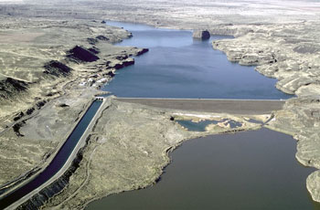
Pinto Dam is a dam in Grant County, Washington.

Michael L. Connor is an American politician and government official. Among other positions in the United States Department of the Interior, he was the former United States Deputy Secretary of the Interior from 2014 until January 20, 2017.

Harold Warren Furman II, "Hal" is an American businessman and a former U.S. government official. He co-founded and serves as the chairman and managing director of The Furman Group, a water infrastructure consulting firm based in Washington, D.C.

Daniel P Beard served as the Commissioner of the United States Bureau of Reclamation, and as the fourth Chief Administrative Officer of the United States House of Representatives.
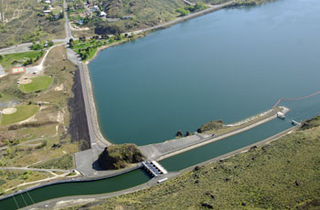
North Dam is an earth-fill embankment dam near the town of Grand Coulee in Grant County, Washington, United States. Construction of the dam began in 1946 and it was completed in 1951. Along with Dry Falls Dam about 22 mi (35 km) to the southeast, North Dam creates the reservoir Banks Lake within the ancient Grand Coulee riverbed. The lake serves as the equalizer reservoir of the Columbia Basin Project. Near the North Dam's left abutment is the entrance to the feeder canal of the project. The canal serves to either deliver water to the Pump-generating plant at Grand Coulee Dam or return water to Banks Lake from the same pumped-storage plant.



























